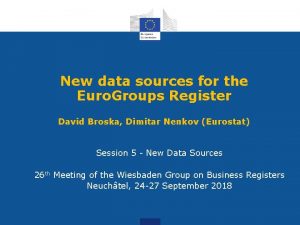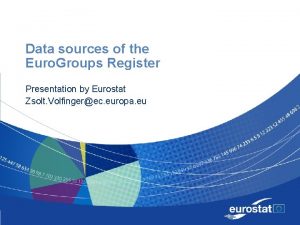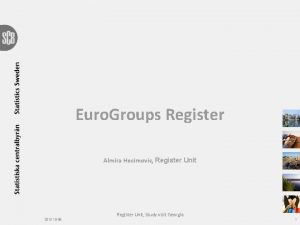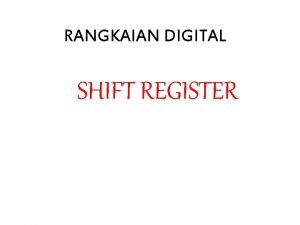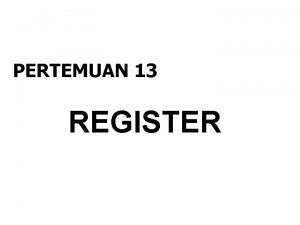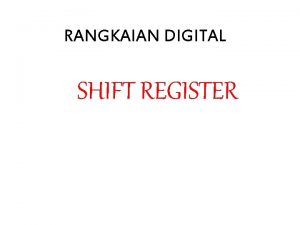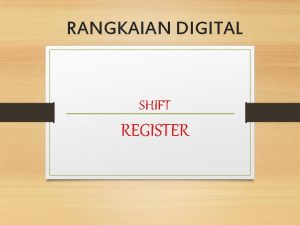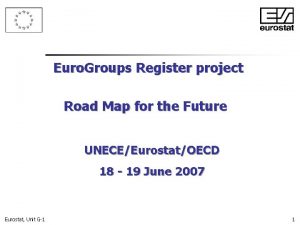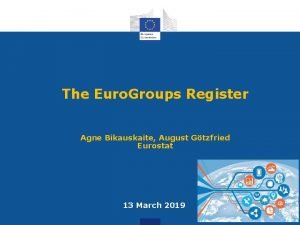New data sources for the Euro Groups Register

















- Slides: 17

New data sources for the Euro. Groups Register David Broska, Dimitar Nenkov (Eurostat) Session 5 - New Data Sources 26 th Meeting of the Wiesbaden Group on Business Registers Neuchâtel, 24 -27 September 2018

Overview 1. Euro. Groups Register (EGR) 2. DBpedia 3. Feasibility study objectives 4. Results for proof of concept • • Coverage Completeness Accuracy Timeliness 5. Conclusion 2

What is EGR? • Eurostat governs the Euro. Groups Register (EGR) • Statistical business register of multinational enterprise groups in the EU and EFTA countries • Coverage: multinational groups present in the EU, their constituent enterprises and legal units • The EGR process is in operation since 2009 • Restricted use in national statistical offices and national central banks of the EU and EFTA countries • For statistical use only 3

Problem statement • In the EGR the EU and EFTA parts of the groups are well-covered • There are missing data for units outside of the EU and EFTA as well as for attributes on the group level • Web crawling and different open data projects are seen as further opportunities to increase the quality of the EGR, its completeness and accuracy • Possible data source of group attributes can be the Wikipedia company profiles 4

Wikipedia company profiles 5

DBpedia • DBpedia is a project that extracts structured data from Wikipedia in order to make it publicly available in a format that overcomes limitations of the latter • Execute sophisticated queries against Wikipedia data • Link different data sets to Wikipedia data

Feasibility study objectives • The project goal was to create an interface that handles a list of group names and returns a list of results with detailed information on those enterprise groups • The contractor, Leipzig University, was provided with a population of 73 group names in order to design an interface that fetches search results from DBpedia 7

Proof of Concept results This Proof of Concept focused on validating the following indicators: • Coverage – number of successfully matched enterprise group names • Completeness – number of received values for the different attributes • Accuracy – quality of the returned values when compared to annual report data • Timeliness – availability of data for certain reference period based on EGR cycle 8

Coverage - reference year 2016 • In order to prove the feasibility of retrieving data from DBpedia, a sample of 73 MNE groups was selected addressing groups size and geographical location diversity • These groups were taken from a data set received from commercial data source Dun & Bradstreet covering a selection of 3000 groups • 70 of those groups could be found in Dbpedia, for those 70 groups at least some information could be retrieved 9

Completeness • In contrast to the high percentage of enterprise groups matched in DBpedia, the number of retrieved attributes for year 2016 is less promising 10

Accuracy: Employment data from DBpedia (GEG) and from annual reports (rep) 11

Accuracy: Turnover data from DBpedia (GEG) and from annual reports (rep) 12

Accuracy: Turnover data • Although the overall accuracy of values is remarkable, there are Dbpedia values close to 0 • This problem occurs when a complex mixture of comma, point and currency is given • In fact the modifiers (million, billion etc. ) are not interpreted correctly • It seems that there will be no 100% correct extractions for every single case in DBpedia 13

Accuracy: total assets data from DBpedia (GEG) and from annual reports (rep) 14

Timeliness: Coverage 2014 -2017 • The DBpedia interface includes a historical mode that allows to retrieve data on groups even if Wikipedia data have already been updated with new data • Due to the delay with which the EGR provides data on enterprise groups this feature is essential Number of retrieved values from DBpedia 15

Conclusion • The results from the feasibility study show that a complete automatization was not achieved • The exported data would require further analysis and human intervention before the data are used • The highest percentage of coverage for persons employed is still below 50% • Persons employed 42. 5% , turnover 37. 0%, assets 16. 4% • The retrieved data on the three parameters showed high accuracy when compared to the figures published by the groups on their websites 16

Thank you! • Questions • Contact: ESTAT-EGR@ec. europa. eu 17
 Print sources and web sources
Print sources and web sources Water resource
Water resource Riverside permit portal
Riverside permit portal How are ethnic groups and religious groups related
How are ethnic groups and religious groups related The terms external secondary data and syndicated
The terms external secondary data and syndicated Euro data cube
Euro data cube Chapter 15 section 3 the new deal affects many groups
Chapter 15 section 3 the new deal affects many groups Kontinuitetshantering i praktiken
Kontinuitetshantering i praktiken Typiska novell drag
Typiska novell drag Nationell inriktning för artificiell intelligens
Nationell inriktning för artificiell intelligens Returpilarna
Returpilarna Shingelfrisyren
Shingelfrisyren En lathund för arbete med kontinuitetshantering
En lathund för arbete med kontinuitetshantering Personalliggare bygg undantag
Personalliggare bygg undantag Tidbok för yrkesförare
Tidbok för yrkesförare Sura för anatom
Sura för anatom Förklara densitet för barn
Förklara densitet för barn Datorkunskap för nybörjare
Datorkunskap för nybörjare


















